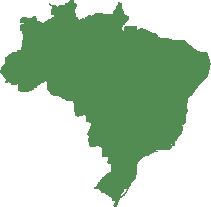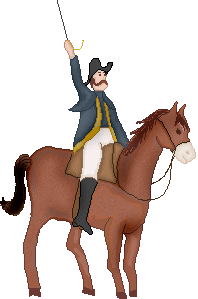Historical
Facts
 |
The
settlement of what is now Brazil began many thousands of years
ago with the arrival of the first tribes of Paleo-American "Indians",
migrants from North America who were probably of Asian origin.
Nomadic hunters and gatherers, they inhabited the less hospitable
parts of the country away from the larger rivers.
 |
|
|
By the
time of the European arrival, a second group had evolved, known
collectively as the tropical forest "Indians". Outnumbering
the nomadic "Indians", they were skilled farmers and
fishermen who occupied the best lands of the Amazon and Paraguay
river systems and most of the coastal plains, making up the bulk
of more than 4.000.000 native inhabitants of Brazil at the time
of the European arrival. |
|
The first
capital of Brazil was the city of Salvador, in Bahia and it was
founded by the Portuguese settler Tomé de Sousa on March
29, 1549. |
Salvador,
Bahia |
|
Rio de Janeiro,
RJ |
Salvador
remained the capital of the country until the year of 1763 when
the capital was moved to Rio de Janeiro in order to protect the
country from the French invaders. |
|
After
the construction of Brasília, in the Federal District
(Distrito Federal) in 1560, Rio ceased to be the capital. |
Brasília,
DF |
|
During
many years Europeans invaded the country. They came in search
of gold, emeralds and other natural resources. Some of them occupied
parts of Brazil for many years until they were finally expelled. |
|
Dom João
VI |
In November,
1807 (one day before Napoleon's troops invaded Lisbon), Dom João
(later Dom João VI), king of Portugal, governing the country
in the place of his mother who was mentally ill, decided to take
refugee in Brazil with his family. He came with and a horde of
nobles and functionaries, arriving in the Brazilian coast on
January 22, in the state of Bahia. |
|
On March
7, the royal family came to the city of São Sebastião,
present Rio de Janeiro. Soon, many reforms took place which altered
the status of the colony. The Bank of Brazil, and the royal printing
office were established, schools were founded and the National
Library was created, and one of the most important reform was
the opening of Brazilian ports to direct trade with all friendly
nations, abolishing the Portuguese commercial monopoly on Brazilian
trade. |
|
With
the end of the Napoleonic Wars, Dom João VI was asked
to return to Lisbon. In the first instance he hesitated and in
1815, he even raised Brazil to the status of kingdom (Reino Unido
de Portugal, Brasil e Algarve - United Kingdom of Portugal, Brazil
and the Algarves). After liberal revolts in Lisbon and Porto
in 1820, the Portuguese demands became too strong for him to
resist. In 1821, Dom João VI left Rio de Janeiro sailing
for Lisbon, leaving his son Dom Pedro as the prince regent in
Brazil. |
Dom Pedro
I |
 |
On September
7, 1822, Dom Pedro called his troops and near the Ipiranga stream,
in São Paulo state, he shouted "Independência
ou morte" ("Independence or death"), solemnly
proclaiming the independence of Brazil. One week later he returned
to Rio de Janeiro, where he was acclaimed by the population.
On December 1, he was crowned and was named Dom Pedro I, becoming
the first emperor of Brazil. |
|
In 1831,
Dom Pedro I abdicated the Brazilian throne in favor of his son
Dom Pedro de Alcântara, later Dom Pedro II, who was only
5 years old. As he could not govern at that age, three regents
were appointed to rule in his place. Dom Pedro de Alcântara
was emancipated at the age of 15 and remained emperor of Brazil
until Marshal Deodoro da Fonseca led the military revolt that
proclaimed the abrogation of the monarchy and the establishment
of Brazil as a republic, on November 15, 1889, deposing the emperor
Dom Pedro II. |
The young
Dom Pedro II |
|
Dom Pedro
II |
Dom Pedro
II was sent into exile in Europe with his family, where he died
two years later. Marshal Deodoro da Fonseca then served as provisional
president until February 1891, when he was elected Brazil's first
President by the constituent assembly, a body largely controlled
by the generals. The newborn republic adopted a federative system
which has kept its same characteristics until today. |
You can
read more detailed information about the history of Brazil HERE.
|
Back
to the Brazilian Menu |
This
page was created on: January 24, 2002.
Last updated on: March 5, 2003.
[
Site
Menu
] [ Home ]
 |
Information
obtained at: 1. The Encyclopædia
Britannica
(Web site)
2. Brasil 500 Anos. Ed. Abril, 1999.
3. Nova Enciclopédia Ilustrada Folha. Folha de São
Paulo. São Paulo, 1996.
~ Graphics by: Graphics
by Irene
~ Sista Scribbles (www.geocities.com/sista_scribbles) ~
~ Graphics by Grace (www.graphicsbygrace.com)
~ The Mother Bear
(www.themotherbear.com) ~ Rajiv's
Graphics
~ |
 |
|
|